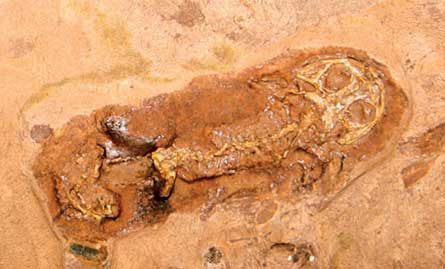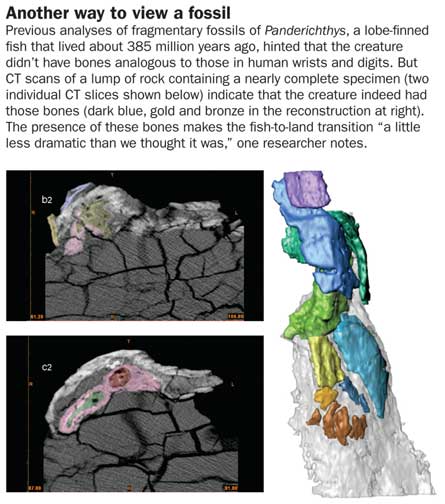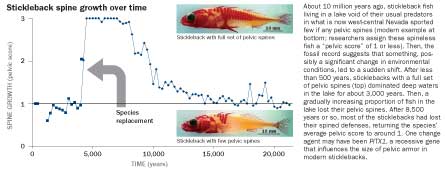When Charles Darwin proposed the idea of evolution in On the Origin of Species, he wrote “if my theory be true, numberless intermediate varieties, linking most closely all the species of the same group together, must assuredly have existed.” At the same time, he bemoaned the dearth of such transitional fossils as perhaps “the most obvious and gravest objection which can be urged against my theory.”
Surely it was serendipity when, just two years later, quarriers unearthed fossils of Archaeopteryx. This creature, now recognized by many scientists as the first known bird, has a mosaic of features that links it with the disparate groups of species on either side of it in the fossil record: While its teeth, tail and overall body shape are distinctly reptilian, its feathers have the same complex structure as the lift-generating feathers of modern birds. In other words, it is just one of the “numberless intermediate varieties” that Darwin predicted must have existed.



“It was the right discovery at the right time,” says Richard Fortey, a paleontologist at the Natural History Museum in London.
Darwin blamed the lack of transitional fossils in part on the poorness of the paleontological record. It’s a rare accumulation of fortuitous events when a creature is fossilized, its remains are preserved over millions of years and then those remains are discovered.
In many cases, that critique still holds true: Researchers have yet to discover fossils of a creature that fits in the gap between bats — which seem to appear suddenly in the fossil record about 54 million years ago — and their mammalian predecessors (SN: 5/14/2005, p. 314). The gap in the fossil record between Archaeopteryx and its reptilian ancestors also remains unoccupied, although several discoveries of feathered dinosaurs in China have given researchers clues about what these still undiscovered intermediate creatures may have looked like.
Many of the gaps in the fossil record that remained unfilled in Darwin’s time now throng with creatures, such as the ones used to chronicle the 48-million–year series of evolutionary changes between whales and their predecessors (SN: 9/22/01, p. 180; SN: 1/5/08, p. 5). And particular biomarkers — chemical fossils, if you will — in rocks more than 240 million years old have provided clues about the evolution of flowering plants (SN: 4/21/01, p. 253).
Paleontologists still randomly stumble across transitional fossils these days, such as a creature found in Texas that falls in a 50-million–year gap in amphibian evolution and helps pin down when the groups that include salamanders and frogs arose.
As often as not, however, transitional fossils are found when researchers head into the field with a specific target in mind: By focusing on rocks deposited during an interval where gaps in the fossil record exist, scientists can boost the chances of making a critical discovery. That’s how researchers unearthed Tiktaalik, a 2.7-meter–long beast that plopped into a 9-million–year gap in the chronicle of vertebrates’ transition from water to land (SN: 6/17/06, p. 379).
Techniques such as CT scanning, used to reinvestigate fossils collected decades ago, have revealed new insights about the anatomy of semiaquatic creatures that preceded Tiktaalik. Even genetic analyses of living creatures can provide insight into the fossil record: The evolutionary changes observed in fossil fish deposited over a time period of 20,000 years in an ancient lake can be linked to a particular gene often studied in that species’ modern-day kin.
Amphibian enigma
Gaps in the fossil record can be large in terms of time — sometimes many millions of years — and in the extent of the evolutionary changes seen when comparing creatures before and after the gap. When Archaeopteryx was discovered, for instance, the fossil record was sparse and the disparity between known fossil reptiles and birds was vast.
Until recently, the gap in the fossil record separating frogs and salamanders from their amphibian ancestors was similarly huge. About 290 million years ago, a diverse assemblage of primitive amphibians walked the land, says Jason Anderson, a vertebrate paleontologist at the University of Calgary in Canada.
But in rocks documenting the 50 million years or so that followed, amphibian fossils are few and far between. Only in rocks deposited after 240 million years ago do such fossils — and specifically, those of frogs and salamanders — appear. These two groups of creatures are distinct both from each other and from their ancestors, and they apparently evolved during an interval for which few fossils have been discovered.
Recently, however, Anderson and his colleagues unearthed Gerobatrachus hottoni, a species whose genus name means “elder frog.” The single specimen unearthed so far is about 11 centimeters long, the size of most modern-day salamanders. It was found in a two-foot-thick knob of 290-million-year-old, fine-grained siltstone in north-central Texas. Even though the fossil was found in rocks deposited just before the start of the lengthy gap in the fossil record, the remains have features characteristic of the frogs and salamanders that presumably descended from it or others like it, Anderson says.
A main clue is that some of the bones in the first and second innermost toes on each of Gerobatrachus’ feet are fused together, a trait characteristic of salamanders but rarely found in other creatures. Because some of the other bones in the fossil aren’t fully developed, Anderson and his colleagues suggest that the creature was a juvenile, indicating the fusion of the toe bones occurred even before adulthood — a stronger sign that it betrays an evolutionary link to salamanders.
But like frogs, Gerobatrachus has a broad skull and a shortened tail, the researchers reported last May in Nature. The shape and configuration of bones in the creature’s skull, and particularly those in its palate, are very froglike. Therefore, “this fossil seals the gap” between primitive amphibians and the frogs and salamanders that evolved later, Anderson says.
On the amphibian family tree, Gerobatrachus and its kin are ancestors to salamanders and frogs, the researchers contend, and the evolutionary split between those two groups probably occurred between 260 million and 270 million years ago.
Gerobatrachus was “quite advanced” compared with other amphibians of its era, he adds. Another way to look at it, he notes, is to consider the amphibians appearing 290 million years ago to be evolutionary holdovers best representing species that first evolved long before.
Getting a foot on land
The series of gradual anatomical changes that enabled semiaquatic creatures to completely leave the water and conquer dry land is one of the most important chapters in the tale of evolution. Among other changes, creatures had to develop limbs to support their weight and develop a way to extract oxygen from the air.
“This whole transition is known from quite a few [species],” says Neil Shubin, a paleontologist at the University of Chicago. Nevertheless, new discoveries — both in the field and in the lab — are still fleshing out the details of these evolutionary developments.
Members of one species considered to be an important part of the water-to-land transition, a lobe-finned fish called Panderichthys, lived in what are now Latvia and Scotland about 385 million years ago. Until recently, the next known member of the evolutionary sequence was a land-adapted creature called Ventastega, which lived on land that is now in the Northern Hemisphere about 365 million years ago. Earlier this decade, Shubin and his colleagues braved the cold of northeastern Canada’s Ellesmere Island to search for fossils to fill that 9-million–year gap. Besides being located in the right place, Ellesmere Island has substantial outcrops of rocks of the right age to hold such fossils, Shubin notes.
He and his team struck paleontological pay dirt with Tiktaalik, which lived about 382 million years ago. Like some fish of the day, the animal had fleshy limbs that ended in fins. But, like land-adapted tetrapods, it had sturdy ribs and a neck (SN Online: 10/15/08). Its fossils also suggest that Tiktaalik had both gills and lungs. Altogether, this blend of features spurred the researchers to dub the creature a “fishapod.”
Fins fringing the end of Tiktaalik’s protolimbs also include bones that are analogous to those in human wrists and fingers. At the time Tiktaalik was found, scientists hadn’t yet discovered similar bones in the fins of predecessors such as Panderichthys, in part because that creature’s fossils are so fragmentary.
In the 1990s, analyses of fossils of Panderichthys and the lobe-finned fish of their era didn’t reveal bony features in the fins. Scientists interpreted this lack as a sign that digits were an evolutionary novelty that only arose later in land-adapted creatures such as Acanthostega, says Per Ahlberg, a vertebrate paleontologist at UppsalaUniversity in Sweden. Lab studies of some modern-day fish such as zebra fish backed up that notion: The second wave of HOX gene activity that leads to the development of digits in tetrapod embryos didn’t occur in those fish, a sign that ancient fish may not have been genetically equipped to make fingers and toes.
However, new analyses of a near-complete specimen of Panderichthys — specifically, a CT scan of a fossil still partially encased in rock — do in fact suggest that those semiaquatic creatures had such bones after all, Ahlberg and colleagues reported last year in Nature. And recent studies in other fish species such as paddlefish and Australian lungfish suggest that a second wave of HOX gene activity can occur during embryonic development in fish. To create a foot, one of the key features of land vertebrates, Ahlberg notes, “all that evolution did was reshape and repattern a structure that was already there.… It didn’t have to build a novel extension of the body from scratch, so the transition from fish to land vertebrate becomes a little less dramatic than we thought it was.”
Hidden genes, big changes
Modern genetic tests are also shedding light on evolutionary changes chronicled in the fossil record of stickleback fish that lived about 10 million years ago in a lake that was in an area now in west-central Nevada. During a 21,500-year interval, one stickleback species — equipped with a full set of pelvic spines — suddenly replaced a species that lacked such protection, only to gradually lose its spines a few millennia later. Because these changes can be tracked from one generation of fish to another throughout a relatively short period, all of the fossils can be considered, in essence, transitional.
Local topography and geology suggest that the lake in question was several kilometers across and that rivers flowing through the region occasionally provided a connection to the Pacific Ocean, says Michael Bell, an evolutionary biologist at StonyBrookUniversity in New York. For the most part, the lake was free of predators: At the site that Bell and colleagues studied, paleontologists have unearthed the fossils of about 20,000 minnow-sized sticklebacks but have found remains of only two trout and one freshwater catfish. The condition of the trout and catfish fossils hints that those fish had lived elsewhere and had been washed to the site as carcasses. Bell and biologist Matthew Travis of RowanUniversity in Glassboro, N.J., reported their findings in October in Cleveland at the annual meeting of the Society of Vertebrate Paleontology.
Bell and his team focused on the stickleback fossils entombed in one band of rock six meters thick. That stratum clearly shows varves, sublayers of sediment each a little less than one-third of a millimeter thick and each, somewhat like a tree ring, preserving the amount of sediment deposited during one year, Bell says. Those varves enabled the scientists to track changes in stickleback anatomy over the 21,500 years. The researchers grouped fossils into 250-year–long periods and categorized the sticklebacks according to the presence or absence of the components that make up the pelvic spine assembly.
At the beginning of the interval, most of the sticklebacks living in this part of the lake had no pelvic spines, but they did have the bony plate on which the spines are attached. Only a few stickleback fossils had a full complement of pelvic spines.
Then, about 4,000 years later, relatively sudden change came to the lake — possibly because of some as-yet-unidentified environmental catastrophe — and the sticklebacks that lacked pelvic spines were supplanted by those that did have pelvic protection. For about 3,000 years, these spine-sporting fish dominated the ecosystem, but then individuals that lacked pelvic spines began to account for an ever-increasing portion of the stickleback population. Eventually, after another 8,500 years or so, most of the sticklebacks in this part of the lake again lacked pelvic spines.
A stickleback’s pelvic spines, like other body parts, require an investment of energy to grow and maintain. If not in danger from predators, an individual benefits if its genetic makeup allows it to forgo those spines, says Bell. That could explain the eventual loss of pelvic spines, he notes, but it doesn’t explain why it took 3,000 years for that phaseout to begin.
Modern genetic studies provide a clue, however. Scientists have identified at least six genes that influence the presence and length of a stickleback’s pelvic spines. Most of those genes have little effect, but one — a recessive gene known as PITX1 — has a significant influence. Not only that, in modern-day sticklebacks, as the expression of the PITX1 gene declines, the spines on the creature’s left side shorten more slowly than those on the right side.
That same pattern of asymmetry shows up in this lake’s fossil record, says Bell. During the 8,500-year period when the sticklebacks were losing their pelvic spines, about 75 percent of the fish fossils with pelvic girdles — precisely the percentage expected in a population with such a recessive gene — had larger remnants on the left sides of their bodies.
Even before the decline in growth of pelvic spines for the sticklebacks kicked in, however, subtle evolutionary changes were taking place, Bell says. Measurements of the spines indicate that during the 3,000 years when all the sticklebacks retained all of their pelvic spines despite danger from predators, the spines were becoming shorter as generations passed. That trend suggests that anatomical changes were happening via one of the other genes known to have an effect on pelvic spines — or possibly via a different gene yet to be discovered in modern relatives.
Genetic studies help explain the changes seen in the fossil record but also offer a cautionary tale for interpreting that record, says Bell. The delayed decline in growth of pelvic spines for the Nevada sticklebacks can be explained by an initially low frequency of the recessive PITX1 gene in that population, Bell and Travis propose. For example, if 1 percent of fish in a group have two copies of such a gene, then the chances of two of them mating and having offspring that also have two copies of the recessive gene are only one in 10,000.
The case of the Nevada sticklebacks illustrates the difficulty in selecting for an extremely rare recessive gene, the researchers propose. “For thousands of years, genetic diversity of a population can be hidden,” Bell notes. For creatures that take many more years to mature and breed than sticklebacks do, the physical manifestation of recessive genes could go undetected in the fossil record for even longer.
Plugging holes
Critics of evolution delight in a simple irony: When paleontologists discover a creature that fills one gap in the fossil record, they create yet another — one that precedes the newly found intermediate species, and one that follows it. Much to evolutionists’ delight, however, paleontologists have remained busy “creating gaps in the fossil record” in recent years. Before the 1970s, scientists discovered an average of 12 new dinosaur genera per decade; since 1990, the rate of discovery has been 10 times higher. (SN: 11/20/04, p. 334).
But post-Darwin discoveries haven’t been limited to large, lumbering land creatures: Scientists have assembled several well-documented evolutionary lineages of foraminifera, single-celled organisms whose distinctive and intricate shells help pin down the era when sediments containing them were deposited. “This is on-the-ground evidence that Darwin wouldn’t have had,” says Fortey of the Natural History Museum in London.
And many stretches of the fossil record poorly represented in Darwin’s day — such as the Precambrian, an era before the Cambrian period (which began about 542 million years ago and is when much of life’s diversity apparently evolved) — are now more thoroughly populated. Fortey notes: “For Darwin, the Precambrian was a complete mystery, whereas now we have a tremendously detailed narrative” for that era, much of it gathered in the past few decades.
As such discoveries pour in, evolutionary trends almost invariably become clearer. “As you find more and more fossils, you close the gaps with more new species,” Fortey adds. In essence, the ever-increasing number of paleontological discoveries is converting a crude connect-the-dots sketch of evolution into a richly detailed pointillist painting.






